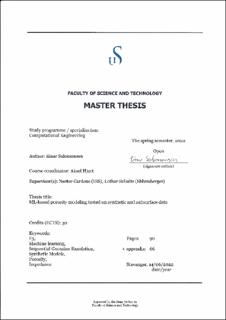| dc.description.abstract | This thesis investigates if synthetic porosity models are useful as a basis for comparison
between machine learning (ML) approaches to porosity prediction. In addition to the ML
methods, the sequential gaussian simulation (SGS) geostatistical method is used as a bench-
mark. The synthetic models are porosity and impedance cubes constructed from the F3 dataset
(offshore Netherlands) well-logs, to mimic specific geological geometries including a sedimentary
wedge and a normal fault. Based on the performance of the different methods on the synthetic
models, a porosity prediction is performed on the actual F3 dataset as well. The prediction
methods discussed are SGS, and ML methods such as KNN-regression, lasso-regression, random
forest-regression, and shallow neural network. The geostatistical and geophysical methods are
run using Petrel, and the ML methods using Python. ML methods are better at minimizing
the error while missing much of the detail of the SGS method. However, for the F3 dataset,
random forest appears to capture more details than the other methods. The synthetic models
provided a better basis for comparison of the different methods, however the workflow requires
improvement. | |
